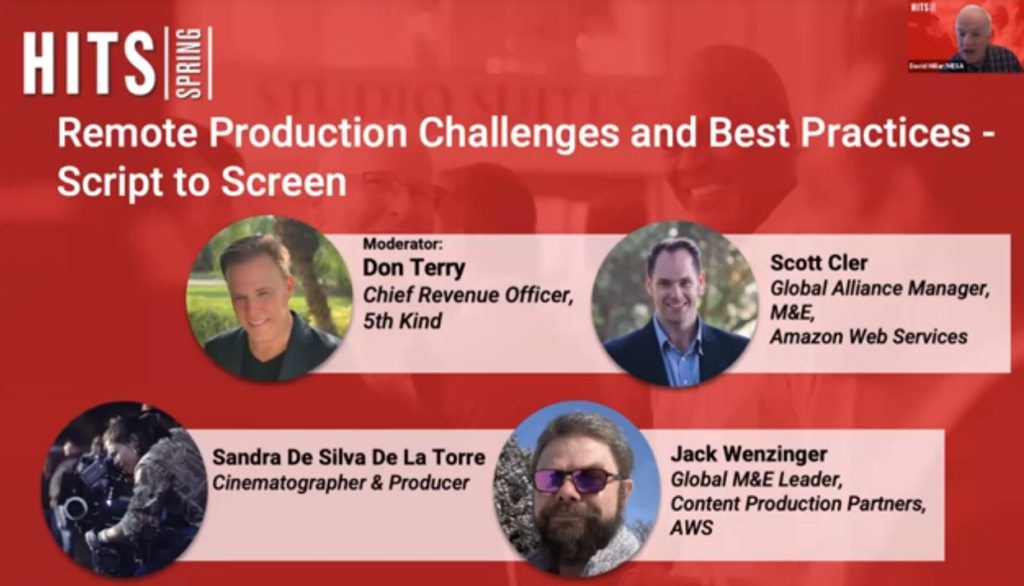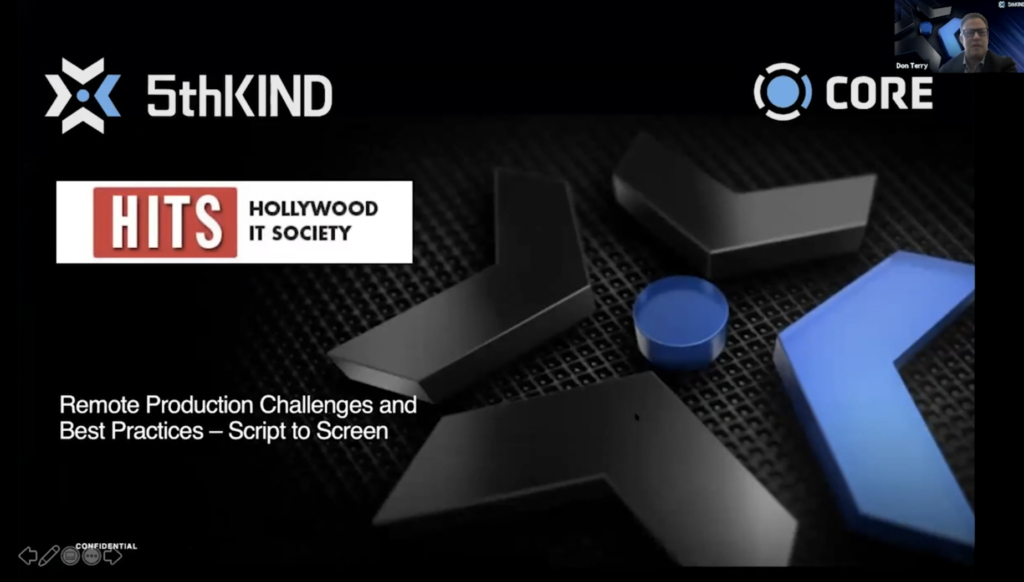
5th Kind, AWS Explore Remote Production Advantages and Challenges
Remote production has provided the media and entertainment sector with many advantages through the COVID-19 pandemic, but challenges remain, according to executives at 5th Kind and Amazon Web Services (AWS) and cinematographer/producer Sandra De Silva De La Torre.
Speaking during the Remote Production & Scale breakout panel presentation “Remote Production Challenges and Best Practices – Script to Screen” May 12 at the annual Hollywood Innovation and Transformation Summit (HITS) Spring event, moderator Don Terry, chief revenue officer at 5th Kind, noted: “We’ve been through a lot” during the pandemic.
He asked De Silva De La Torre about her recent experience with remote production during the making of the short film “La Inquilina,” a thriller about two women sharing the same house during the pandemic, and how technology helped.
De Silva De La Torre, who was born in Paris and grew up in Mexico, explained: “Like everybody else in the industry and in the world, we stopped [production] here in Mexico.” While shooting, those working on the film, a project for the Hollywood Professional Association (HPA), had to stop filming and go into lockdown, she noted, pointing out that “all the productions were shutting down” in the country, where there was a large outbreak.
 “Technology helped us a lot” during the making of the film, she said, noting that, for one thing, all meetings were conducted via Zoom and Evercast. Also, “every single piece of information [was] produced through 5th Kind so every single member of the crew knew exactly what was going on,” she said.
“Technology helped us a lot” during the making of the film, she said, noting that, for one thing, all meetings were conducted via Zoom and Evercast. Also, “every single piece of information [was] produced through 5th Kind so every single member of the crew knew exactly what was going on,” she said.
“We didn’t have to have that many meetings” during pre-production as a result, she noted. During production, after the shift to remote, rushes were sent from the production site to those working on the film in Colombia so they can “start putting it together,” while somebody else working on the film in Germany was “able to see what happening on set” thanks to AWS and 5th Kind, she said.
That was “really convenient,” she explained, noting it was her first time working on a remote production. It was a “better way to do things quicker and more productive,” she said.
However, there continue to be several challenges when it comes to remote production, even with the many advancements that have been made.
Based on what Scott Cler, global alliance manager, M&E at AWS, said he had been hearing from friends who create filmed content, “one of the big challenges is the reduced number of crew that you can have on set,” he noted.
“One of the things that I thought was so great” during the making of “La Inquilina” was, through a partnership with Teradek and 5th Kind, being able to have “that live stream coming from set immediately,” Cler said. It is “technology like that, frankly, that’s going to allow us to be more tactical and safe as we’re re-engaging with production shoots going forward,” he added.
Calling that a “great point,” Matthew Herson, principal solutions architect at AWS, said technology has been used to “expand your customer experience and your shot experience.” Although “people are not allowed on set or there’s limited quantities [of them], there’s still resources that are required,” including remote view, the script, plus all the COVID protocols that need to be followed “as far as documentation and tracking,” he pointed out.
5th Kind served as a “great place to put all that information and a central source in order to be usable and accessible from really anywhere around the world,” Herson said.
Noting that people working on the film were based in places including Germany, Mexico City and Los Angeles, Herson said: “We’re all able to get a uniform access and view to all of the material, whether it’s been live captured or moving into the editorial process. It really changes the idea of having to make stopping points to move through the editorial or workflow process and make it more seamless, so really accelerating the timeline.”
Terry agreed with him, saying: “We certainly see different use cases for rendering, different use cases for different pipelines around VFX…. Non-linear editorial has been the dream for a long time… and I think the cloud and essentially COVID has helped accelerate a lot of that.”
The technology has made it possible to “work with a lot of people around the world without any restraint or problems” – other than the “time zones may be confusing,” De Silva De La Torre said with a laugh.
 Also, being able to collaborate from “one single place and work from there, I think that’s fantastic and I think that’s something that is going to keep on going and growing,” she said. More editing and color correcting in the cloud will also “be the future,” she predicted.
Also, being able to collaborate from “one single place and work from there, I think that’s fantastic and I think that’s something that is going to keep on going and growing,” she said. More editing and color correcting in the cloud will also “be the future,” she predicted.
High-speed Internet, however, is another remaining challenge, according to Herson, who said: “We take high-speed Internet for granted.” After all, “in so many places across the United States and even the world … it’s spare [and] very hard to find” still.
Another challenge is that “a lot of these systems are easy to deploy on their own but to deploy an end-to-end total system or production system still requires a little bit of work to be candid,” Herson said. There’s no easy way of just saying ‘OK, I need everything and go’ [with] one button. And I don’t think that’s a big ask in the world to say ‘I want everything in one shot’ but… I would say that making it seamless [and] to be able to create an integrated map would be really helpful and I think that’s something we all need to work on.”
To view the entire presentation, click here.
HITS Spring was presented by IBM Security with sponsorship by Genpact, Irdeto, Tata Consultancy Services, Convergent Risks, Equinix, MicroStrategy, Microsoft Azure, Richey May Technology Solutions, Tamr, Whip Media, Eluvio, 5th Kind, LucidLink, Salesforce, Signiant, Zendesk, EIDR, PacketFabric and the Trusted Partner Network.
